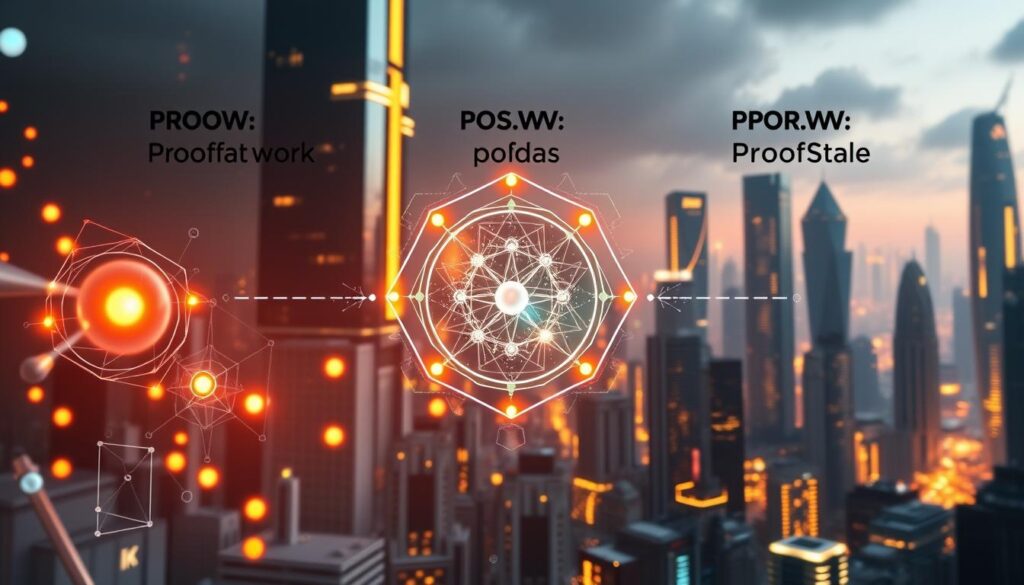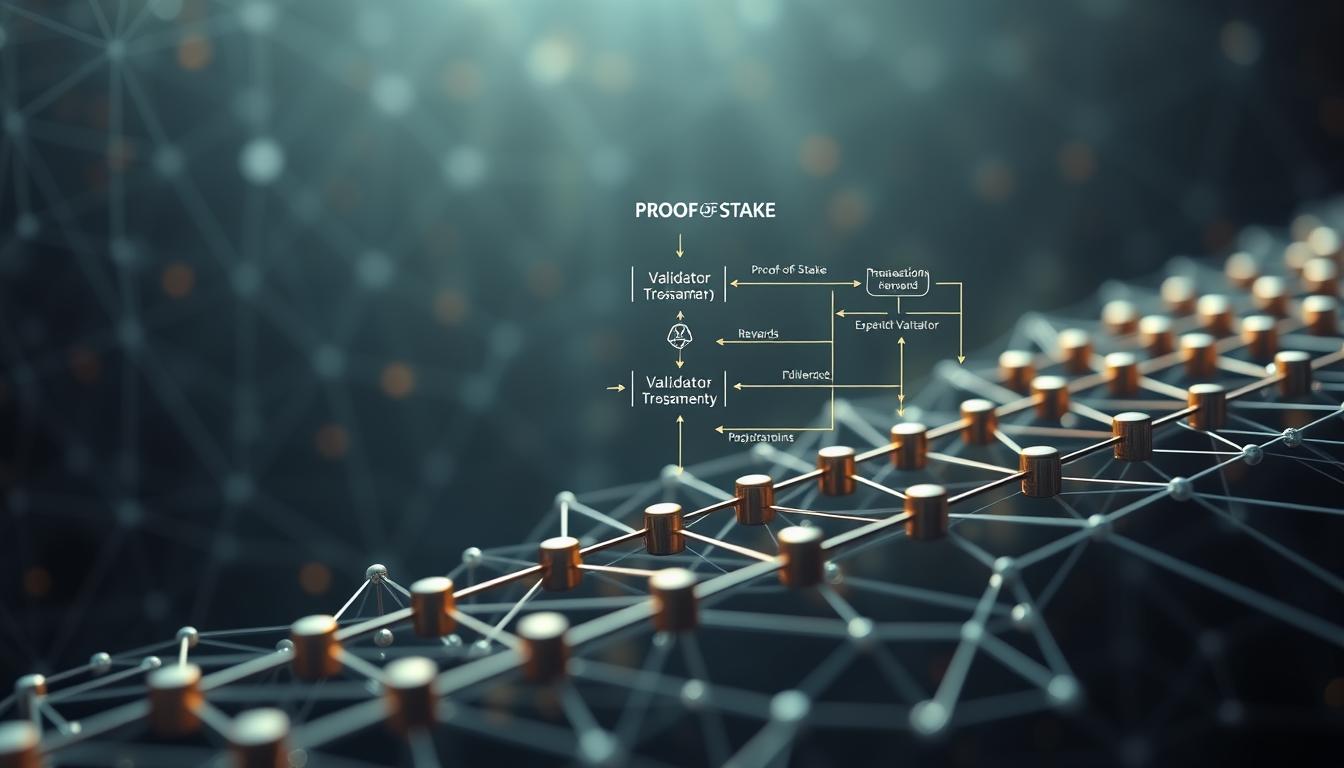Now Reading: How Machine learning blockchain consensus algorithm Works
- 01
How Machine learning blockchain consensus algorithm Works
How Machine learning blockchain consensus algorithm Works

Distributed networks rely on a special kind of agreement system. This system ensures every computer in the network has the same information. It’s a critical part of modern digital ledgers.
This technology became widely known after a 2008 paper. The paper described a peer-to-peer electronic cash system. The first block in this system was created in 2009, marking a major step forward.
Now, new methods are making these systems smarter. They combine predictive analytics with secure agreement protocols. This creates more efficient and intelligent networks for processing data.
This guide explores this powerful combination. We will look at how it enhances security and performance. Understanding this integration is key for building next-generation systems.
Key Takeaways
- Consensus algorithms are essential for maintaining agreement across a distributed network of computers.
- Blockchain technology enables a tamper-evident ledger without a central controlling authority.
- The integration of intelligent systems creates adaptive and more efficient network operations.
- This combination represents a significant evolution in how decentralized architectures function.
- Understanding these mechanisms is crucial for developers and organizations.
Introduction to Machine Learning Blockchain Consensus Algorithm
Traditional agreement protocols in decentralized networks have inherent limitations that need addressing. These systems often struggle with efficiency, scalability, and adaptability to changing network conditions.
The integration of intelligent systems with distributed ledger technology creates a powerful combination. This approach aims to solve critical challenges including energy consumption, performance bottlenecks, and security vulnerabilities.
Purpose and Scope
This integration serves multiple important purposes. It enhances traditional methods while preserving core principles of decentralization and trustlessness.
The scope covers various artificial intelligence techniques applied to network operations. These include:
- Supervised approaches for transaction classification
- Unsupervised methods for anomaly detection
- Reinforcement techniques for adaptive parameter optimization
These methods leverage publicly available information to train models. The trained models can predict network behavior and identify suspicious activity.
The ultimate goal is achieving optimal balance between security, decentralization, and transaction throughput. This represents a significant step forward in distributed system design.
Blockchain Technology: Fundamentals and Developments
At its heart, a blockchain is a continuously growing list of records, secured and linked using advanced cryptography. This system creates a distributed ledger that allows for secure, transparent, and unalterable storage of data.
It operates across a peer-to-peer network of computers, known as nodes. Each node keeps a full copy of the ledger. This ensures no single point of failure or control exists.
Individual transactions are grouped together into a block. Each new block contains a timestamp and a unique cryptographic link to the previous block, forming a chain.
The technology has evolved significantly since its 2008 debut. A major development was the 2015 launch of Ethereum. It introduced programmable smart contracts, expanding use cases far beyond simple transactions.
Access to a blockchain network can vary, defining its type:
- Public: Open for anyone to participate.
- Consortium: Controlled by a pre-selected group.
- Private: Operated by a single organization.
These core features of decentralization and immutability make the technology ideal for applications requiring trust and traceability.
The Evolution of Machine Learning and Consensus Mechanisms
Achieving reliable agreement across decentralized networks has been a persistent challenge since the 1950s. Early theoretical work established the foundation for modern distributed systems.
Historical Milestones
The late 1950s saw the first proposals for agreement protocols as probability functions. These early concepts classified systems into two main categories.
Byzantine fault-tolerant approaches accounted for potentially malicious nodes. Non-Byzantine methods assumed more reliable network participants.
Significant advances came in the late 1980s. Leslie Lamport’s Paxos algorithm in 1989 represented a major step forward in distributed computing theory.
Recent Innovations
The 2008 introduction of Bitcoin marked a paradigm shift. Its Proof-of-Work system demonstrated Byzantine fault tolerance in practice.
Recent developments address limitations of earlier methods. New approaches balance security, energy efficiency, and decentralization.
Research documented in Google Scholar shows growing interest in intelligent optimization. These studies explore how artificial intelligence can enhance network operations through predictive analytics and adaptive parameter adjustment.
Key Consensus Algorithms: PoW, PoS, and PoDaS
Three primary models guide how participants in a distributed network reach a common decision. Each method has distinct strengths and trade-offs. Understanding these differences is crucial for evaluating system performance.

These protocols ensure all nodes agree on the ledger’s state. They prevent fraud and maintain system integrity without a central referee.
Proof of Work: Benefits and Drawbacks
The proof-of-work consensus mechanism was the first successful implementation. It requires miners to solve complex puzzles. This process provides robust security but consumes vast amounts of energy.
Proof of Stake: Energy Efficiency and Fairness
Proof-of-stake selects validators based on their held currency. It dramatically reduces power consumption. This approach offers greater scalability but raises questions about potential centralization.
Hybrid Approaches and PoDaS Insights
Newer models like PoDaS combine elements from different protocols. They aim for a better balance between security, speed, and fairness. These innovative systems represent the next evolutionary step.
| Algorithm | Primary Mechanism | Key Advantage | Main Challenge |
|---|---|---|---|
| Proof-of-Work (PoW) | Computational puzzle solving | Proven security and decentralization | Extremely high energy use |
| Proof-of-Stake (PoS) | Staking cryptocurrency holdings | High energy efficiency | Risk of wealth-based centralization |
| Proof of Data Sharing (PoDaS) | Federated learning workload as proof | Optimized performance and fairness | Relative novelty and complexity |
PoDaS uses useful computational work for validation. This hybrid method achieves faster block times than PoW. It also maintains high accuracy, showing great promise for future networks.
Integrating Machine Learning into Blockchain Networks
The fusion of artificial intelligence with distributed ledger systems presents unique implementation challenges that require strategic planning. Research spanning 2008 to 2023 identified 159 studies exploring this integration, with nearly half focusing on anomaly detection.
Classification tasks represented 46.5% of applications in these studies. These approaches help categorize transactions and identify potential threats within decentralized systems.
Implementation Strategies
Three primary deployment models have emerged for combining intelligent systems with distributed ledgers. Each approach balances computational efficiency with decentralization requirements.
On-chain execution runs models within smart contracts directly on the network. Off-chain analysis processes data externally before returning insights. Hybrid methods combine both approaches for optimal performance.
Federated learning shows particular promise for these networks. This technique allows collaborative model training without sharing raw data between participants.
| Implementation Approach | Data Processing Location | Primary Advantage | Key Limitation |
|---|---|---|---|
| On-Chain Execution | Within smart contracts | Maximum transparency and auditability | High computational costs |
| Off-Chain Analysis | External systems | Efficient processing of large datasets | Reduced decentralization |
| Hybrid Model | Combined on/off-chain | Balanced performance and security | Increased complexity |
| Federated Learning | Distributed across nodes | Privacy preservation | Coordination challenges |
Successful integration requires addressing scalability concerns. Over 31% of studies used datasets exceeding one million data points. Platforms like Bitcoin received the most research attention at 47.2%.
These implementation solutions must ensure model transparency while preventing adversarial attacks. They represent the next evolution in intelligent distributed systems.
Supply Chain Management and Blockchain Applications
Traditional supply chain systems suffer from fragmented data storage and limited transparency. Multiple organizations create information barriers that prevent real-time visibility. These challenges impact operational efficiency across complex global networks.
Enhancing Transparency and Efficiency
Distributed ledger technology transforms how companies manage supply chains. It provides a shared, immutable record that authorized participants can access. This enables real-time tracking of goods and verification of authenticity.
The technology ensures information cannot be altered once recorded. All network participants verify transactions through established protocols. This creates decentralized trust without requiring central authorities.

Advanced analytical methods can be integrated with these systems. They help predict demand patterns and detect anomalies in logistics. Historical transaction data supports intelligent routing optimization.
Real-world implementations demonstrate measurable benefits. Companies experience reduced fraud and faster dispute resolution. Improved inventory management and strengthened collaboration are key advantages.
Smart Contracts and Distributed Ledger Insights
Self-executing digital agreements represent a revolutionary advancement in how automated transactions are processed across decentralized systems. These programs run exactly as programmed without third-party interference.
Ethereum’s 2015 launch introduced a virtual computing environment that enabled sophisticated contract development. This technology allows developers to create diverse applications across multiple sectors.
Smart contracts operate as program instances replicated across all network nodes. This ensures transparency and resistance to manipulation. The code executes automatically when predetermined conditions are met.
| Application Sector | Primary Function | Security Requirements | Scalability Needs |
|---|---|---|---|
| Decentralized Finance | Automated lending and trading | High financial security | High transaction volume |
| Supply Chain | Delivery verification and payment | Data integrity protection | Moderate volume |
| Healthcare | Privacy-preserving data access | Patient confidentiality | Variable demands |
| Energy Management | Grid coordination and billing | System reliability | Real-time processing |
Security considerations remain critical for contract deployment. Vulnerabilities can lead to significant losses requiring thorough auditing. Advanced tools analyze contract code to identify potential risks.
Distributed ledger insights from contract data reveal transaction patterns and optimization opportunities. This information helps detect anomalous behavior indicating security threats.
Exploring Merkle Trees and Cryptography in Blockchain
The mathematical foundation of secure digital ledgers relies on sophisticated tree-based structures. These systems enable efficient verification of large datasets without transmitting complete information.

Cryptographic validation methods are essential for maintaining trust across distributed networks. They ensure information integrity through advanced mathematical principles.
Understanding Merkle Tree Architecture
Merkle trees organize information in a hierarchical binary structure. Each leaf contains a hash of individual data pieces.
Parent nodes combine hashes from their children recursively. This continues until reaching a single root hash. The root provides a compact fingerprint of all contained data.
This architecture allows quick verification of specific entries. You only need the target data and a minimal proof path.
Role of Cryptographic Hashing
Cryptographic hashing creates one-way functions that transform input data. These functions produce fixed-length outputs from variable inputs.
Any modification to original data changes the resulting hash completely. This property enables immediate detection of tampering attempts.
Hashing extends beyond tree structures to block linking and address generation. It forms the security backbone of distributed systems.
| Verification Method | Data Required | Security Level | Efficiency |
|---|---|---|---|
| Full Block Download | Complete block data | Maximum | Low |
| Merkle Proof | Transaction + minimal hashes | High | Excellent |
| Simple Hash Check | Single hash value | Basic | Maximum |
For developers seeking deeper technical knowledge, our comprehensive blockchain development tutorial covers advanced implementation techniques.
Federated Learning in Blockchain Data Analysis
Federated learning introduces a paradigm where models learn from data without ever moving the data itself. This distributed approach is particularly powerful when integrated with decentralized ledgers. It enables collaborative intelligence across a network while upholding strict data security principles.
Data Privacy and Model Aggregation
In this system, each participant trains a model on their local data. Sensitive information stays securely on-premises. Only the model’s updates, not the raw data, are shared with the network.
This process protects privacy by design. Techniques like encrypted sharing and differential privacy add extra layers of security. They prevent anyone from identifying the source of specific updates.
The aggregation phase combines these validated updates from all nodes. A central server or a smart contract performs this task. It creates a new, improved global model that benefits everyone.
The FLchain concept formalizes this integration. The ledger’s agreement protocol verifies each step. This creates a transparent and tamper-proof record of the entire model evolution.
Practical uses are growing rapidly. Hospitals can jointly train diagnostic tools without sharing patient records. Financial institutions can improve fraud detection models collaboratively. All while maintaining strict confidentiality.
The Impact of IoT on Blockchain Consensus
The explosion of connected devices in the Internet of Things (IoT) is reshaping the requirements for agreement protocols in distributed systems. Billions of smart devices create a massive, resource-constrained network with unique demands.

This scale presents significant hurdles for traditional methods. Many endpoints have limited power and computing ability. They also need fast transaction processing for real-time operations.
Integrating distributed ledger technology directly addresses core security flaws in standard IoT setups. It eliminates single points of failure and provides strong authentication. This creates a transparent, tamper-proof record for all device communications.
These integrations are paving the way for more secure device ecosystems.
Enabling Secure Device Interactions
Establishing trust between countless devices is a primary goal. Systems assign cryptographic identities to each gadget. Smart contracts then define and enforce strict access policies automatically.
For example, research shows applications in medical environments. Systems can identify and track unauthorized drones. The underlying technology prevents illegal access and data manipulation, protecting patient safety.
A semi-centralized trust model often helps manage this complexity. Smart contracts dynamically evaluate the trust value of each device based on its behavior. While initial trust may be assigned by central nodes, the system becomes more distributed over time.
| Security Aspect | Traditional IoT Architecture | Blockchain-Enhanced IoT |
|---|---|---|
| Data Integrity | Vulnerable to tampering | Immutable logs prevent alteration |
| Device Authentication | Often weak or nonexistent | Cryptographic identities ensure validity |
| Audit Trail | Fragmented and opaque | Transparent and verifiable record |
| Trust Management | Centralized and static | Dynamic and distributed evaluation |
This approach creates a robust foundation for the future of connected devices. It ensures security and reliability at an unprecedented scale.
Energy Efficiency and Sustainability in Consensus Mechanisms
Environmental concerns have pushed energy efficiency to the forefront of distributed network design. The massive electricity demands of early systems created serious sustainability questions. This challenge became a major focus for researchers and developers.
The proof work approach requires extensive computational power. Thousands of nodes compete to solve complex puzzles simultaneously. This creates significant energy waste since only one node wins each round.
Quantitative analysis reveals the scale of this challenge. Some networks consume electricity comparable to entire countries. This makes efficiency improvements an environmental imperative.
Proof stake mechanisms represent a major advancement. They reduce power consumption by approximately 99% compared to proof work. Validators are selected based on economic stake rather than computational power.
The PoDaS approach demonstrates how hybrid methods achieve balance. It repurposes useful computational work for validation purposes. This eliminates wasteful puzzle-solving while maintaining security.
Sustainability extends beyond energy consumption to hardware lifecycle management. It includes renewable energy integration and long-term system viability. These considerations are now central to protocol design.
Security and Data Integrity in Blockchain Networks
Maintaining robust protection for digital ledgers requires a multi-layered approach to prevent unauthorized changes. This system combines advanced cryptography, decentralized architecture, and economic incentives.
These features work together to create a highly resistant environment. The integrity of all recorded data is a top priority.
Defending Against Malicious Attacks
Distributed systems must operate correctly even when some participants are dishonest. Byzantine fault-tolerant protocols are designed for this exact scenario.
They ensure the network reaches agreement despite malicious nodes attempting to disrupt operations. This prevents issues like double-spending.
Common threats to system safety are varied. A recent scientific report details the evolving landscape of these digital risks.
| Attack Type | Method of Operation | Primary Defense |
|---|---|---|
| 51% Attack | Controlling majority computational power | Decentralized participant distribution |
| Sybil Attack | Creating numerous fake identities | Costly identity verification mechanisms |
| Eclipse Attack | Isolating a node from honest peers | Robust peer-to-peer connection management |
| Smart Contract Exploit | Abusing code vulnerabilities | Rigorous code auditing and formal verification |
Any change to transaction data is immediately detectable. This is due to the cryptographic linking of blocks and Merkle tree structures.
The root hash of the tree acts as a unique fingerprint. Altering a single piece of information changes this fingerprint completely.
Consensus Challenges and Future Innovations
While distributed ledger systems have achieved remarkable stability, several fundamental hurdles continue to challenge their widespread adoption. These limitations span technical performance, interoperability between different networks, and the absence of universal standards.
The famous trilemma presents a core difficulty for validation methods. Improving security often reduces decentralization. Enhancing scalability can compromise both. Finding the optimal balance remains an active research area.
Scalability and Cross-Chain Interactions
Transaction throughput represents a significant bottleneck for many networks. Traditional validation protocols process far fewer transactions than centralized systems. This limitation affects real-world application potential.
Cross-network communication introduces additional complexity. Different systems use incompatible security models and rule sets. New approaches must enable secure asset transfers between these separate environments.
| Scalability Solution | Core Mechanism | Primary Benefit | Current Status |
|---|---|---|---|
| Sharding | Network partitioning into parallel chains | Dramatically increased throughput | Experimental implementation |
| Layer-2 Protocols | Off-chain transaction processing | Reduced main network congestion | Growing adoption |
| DAG Structures | Concurrent transaction validation | Elimination of block creation delays | Research phase |
Emerging Trends and Research Directions
Standardization frameworks represent a critical gap in current ecosystem development. Without common evaluation metrics, comparing different approaches becomes challenging. This drives research toward formal verification methods.
Publications in Google Scholar show growing interest in adaptive parameter optimization. Other promising directions include quantum-resistant cryptography and sustainable design principles. These innovations address both current and future needs.
Novel computational techniques specifically designed for ledger applications show particular promise. They can optimize system parameters dynamically while preserving privacy through collaborative frameworks.
Machine learning blockchain consensus algorithm: A Technical Overview
Modern distributed systems are evolving beyond traditional validation methods through computational intelligence integration. This technical approach embeds analytical capabilities directly into network operations.
Algorithm Analysis and Performance Metrics
The PoDaS method demonstrates practical implementation through a three-phase process. Nodes first train models on local data and upload encrypted parameters.
Mining participants then validate these updates by retraining on sample information. Finally, verified parameters combine through weighted averaging.
Performance evaluation reveals significant advantages. The system achieves 96.00% model accuracy while optimizing block generation times.
This represents a substantial improvement over traditional approaches. The integration eliminates wasteful computational efforts while maintaining security.
Technical features include adaptive parameter adjustment and predictive validation capabilities. These elements enhance network responsiveness to changing conditions.
Implementation requires addressing challenges like model determinism and update management. Ensuring all nodes reach identical results remains critical for system integrity.
Advanced Research and Case Studies from Google Scholar
Academic databases reveal a dramatic surge in scholarly investigations into intelligent distributed systems over the past decade. A comprehensive analysis examined 159 publications spanning 2008 to 2023. This systematic mapping study confirms the growing relevance of computational approaches to network validation.
Notable Experimental Outcomes
Recent studies demonstrate impressive technical achievements. Federated learning applications achieved 96.00% accuracy in model validation. Anomaly detection systems reached over 95% precision in identifying suspicious network activity.
Hybrid validation methods showed remarkable energy efficiency improvements. They reduced consumption by 99% compared to traditional approaches while maintaining security. These results highlight the practical benefits of computational optimization.
Insights from Recent Publications
Research identifies several persistent challenges that require attention. Overfitting remains a common issue where models perform well on training data but poorly on new information. Interpretability difficulties also persist, making it hard to explain specific predictions.
The analysis reveals significant research gaps worth exploring. Standardization frameworks are needed for fair comparison between different approaches. Cross-network interactions and scalability issues represent additional areas for development.
| Research Focus Area | Publication Percentage | Primary Challenge | Future Direction |
|---|---|---|---|
| Cryptocurrency Prediction | Most Popular Topic | Model Overfitting | Improved Generalization |
| Classification Tasks | 46.5% of Studies | Interpretability Issues | Explainable AI Integration |
| Large Dataset Analysis | 31.4% of Papers | Computational Demands | Efficient Processing Methods |
| Bitcoin-focused Research | 47.2% of Studies | Network Specificity | Cross-Platform Solutions |
Conclusion
The journey through intelligent distributed systems reveals a path toward more adaptive digital infrastructures. This integration represents a significant advancement in how networks achieve trust and efficiency.
These solutions combine predictive capabilities with secure validation methods. They address critical challenges like energy consumption and scalability limitations.
Practical applications across multiple sectors demonstrate real-world value. From supply chains to healthcare, these systems provide transparent and efficient operations.
Future innovations will focus on standardization and interoperability. The continued evolution of this technology promises more resilient and sustainable networks.
Understanding these mechanisms is essential for developers and organizations. They represent the foundation for next-generation digital environments.
FAQ
What is the main goal of combining machine learning with a blockchain consensus mechanism?
The primary goal is to create a smarter, more adaptive system. This integration aims to improve network security, increase transaction throughput, and enhance energy efficiency. It allows the network to learn from transaction data and adjust its rules dynamically.
How does a machine learning consensus algorithm improve supply chain management?
It significantly boosts transparency and traceability. By analyzing patterns in the distributed ledger, the system can predict delays, verify authenticity, and automatically trigger smart contracts. This leads to greater efficiency and data integrity across the entire chain.
What are the key differences between traditional mechanisms like Proof of Work (PoW) and a machine learning-enhanced approach?
Traditional systems like PoW rely on fixed, computationally intensive puzzles. A learning-based approach introduces adaptability. It can optimize block creation times and resource allocation based on real-time network conditions, moving beyond static rules.
Can these advanced algorithms work with Internet of Things (IoT) devices in a blockchain network?
Absolutely. Integrating these technologies is a major innovation. It enables secure, autonomous interactions between countless devices. The consensus mechanism can manage the vast data streams from sensors, ensuring reliability and robust data security for smart environments.
What role does federated learning play in maintaining privacy within these networks?
Federated learning is crucial for privacy. It allows individual nodes to train local models on their own data without sharing raw information. Only model updates are aggregated on the blockchain, preserving confidentiality while still improving the collective intelligence of the system.
Where can I find credible research on these emerging technologies?
Platforms like Google Scholar are excellent resources. They host numerous peer-reviewed papers on hybrid consensus mechanisms, cryptographic hashing, and real-world case studies. These publications offer deep insights into current experimental outcomes and future trends.















